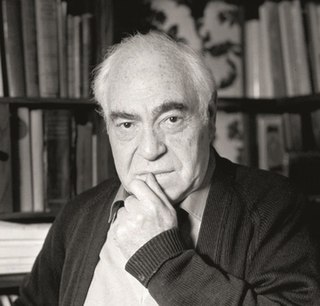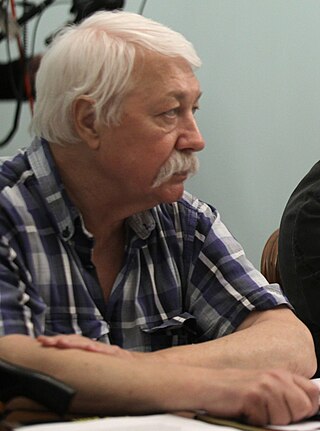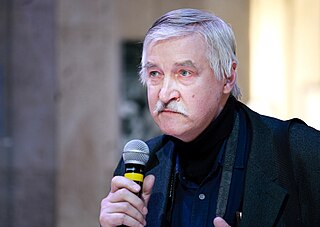
Yuri Borisovich Norstein is a Soviet and Russian animator best known for his animated shorts Hedgehog in the Fog and Tale of Tales. Since 1981, he has been working on a feature film called The Overcoat, based on the short story by Nikolai Gogol of the same name. According to The Washington Post, "he is considered by many to be not just the best animator of his era, but the best of all time".
The history of Russian animation is the visual art form produced by Russian animation makers. As most of Russia's production of animation for cinema and television were created during Soviet times, it may also be referred to some extent as the history of Soviet animation. It remains a nearly unexplored field in film theory and history outside Russia.

Soyuzmultfilm is a Russian animation studio based in Moscow. Launched on June 10, 1936 as the animated film production unit of the U.S.S.R.'s motion picture monopoly, GUKF, Soyuzmultfilm has produced more than 1,500 cartoons. Soyuzmultfilm specializes in the creation of animated TV series, feature films and short films. The studio has made animated films in a wide variety of genres and art techniques, including stop motion, hand-drawn, 2D and 3D techniques.

Fyodor Savelyevich Khitruk was a Soviet and Russian animator and animation director.

Yevgeny Tikhonovich Migunov was a Russian artist, cartoonist, book illustrator, animation and art director, screenwriter, inventor, educator and memoirist. He is regarded as one of the leading innovators during the Khrushchev Thaw who contributed significantly to both traditional and stop motion animation.
Leonid Alekseyevich Amalrik was a Soviet animator and animation director. He was named Honoured Artist of the RSFSR in 1965.
Yefim Abramovich Gamburg was a Soviet and Russian animation director known for parody and musical cartoons. He was named Meritorious Artist of RSFSR in 1986. Member of ASIFA.

There Lived Kozyavin is a 1966 Soviet animated short directed by Andrei Khrzhanovsky, written by Lazar Lagin and Gennady Shpalikov.
Masters of Russian Animation is a Russian four-DVD animation collection that contains 45 short animations and stop-motion animations. Animated in the Soviet Union and later released in 2000, the cartoons contain different styles in animation and painting. The animations were released from different years, beginning with the oldest, Story of One Crime (1962), to the more recent, Croak X Croak (1991).
Glass harmonica may refer to:

Eduard Vasilievich Nazarov was a Soviet and Russian animator, screenwriter, voice actor, book illustrator and educator, artistic director at the Pilot Studio (2007–2016), vice-president of ASIFA (1987–1999) and a co-president of the KROK International Animated Films Festival. He was awarded People's Artist of Russia in 2012.
Boris Pavlovich Stepantsev was a Soviet and Russian animation director, animator, artist and book illustrator, as well as a vice-president of ASIFA (1972–1982) and creative director of the Multtelefilm animation department of the Studio Ekran (1980–1983). Honored Artist of the RSFSR (1972).
Roman Vladimirovich Davydov was a Soviet and Russian animation director, animator, artist and educator. Honored Art Worker of the RSFSR (1979).
Valentina Semyonovna Brumberg and Zinaida Semyonovna Brumberg, commonly known as the Brumberg sisters, were among the pioneers of the Soviet animation industry. In half a century they created around 50 films as animation directors, animators and screenwriters, always working together. They were named Meritorious Artists of the RSFSR in 1968.
Gennady Mikhailovich Sokolsky was a Soviet and Russian artist, animation director, animator, art director and screenwriter at Soyuzmultfilm. Sokolsky took part in over 170 projects, including the Happy Merry-Go-Round animated series which he co-created with several friends. Member of ASIFA.
Anatoly Alexeyevich Petrov was a Soviet and Russian animation director, animator, artist and educator at VGIK known as the founder of the long-running anthology series Happy Merry-Go-Round and developer of the animation technique he called photographics. A member of ASIFA, he was named Meritorious Artist of the RSFSR in 1989.

The Nose or the Conspiracy of Mavericks is a 2020 Russian animated film. The film is created by the animation studio School-Studio "Shar". People's Artist of Russia animator, Andrei Khrzhanovsky directed the film. The film is based on the Russian classic, The Nose by Nikolai Gogol. The script writers Yuri Arabov and Andrei Khrzhanovsky adapted the 19th-century prose of Gogol as well as the verses of the opera of the same name by Dmitri Shostakovich into an animated film featuring a mixture of drawings, cut-outs, live-action, and documentary style filming.
Arthouse animation is a combination of art film and animated film.

Leonid Viktorovich Nosyrev is a Soviet and Russian director-animator, screenwriter, artist, animator. Laureate of the Prize of the President of the Russian Federation in the field of literature and art for works for children and youth (2019). Honored Art Worker of the Russian Federation (2003). Winner of National Animation Awards (2020).
The Glass Harmonica is a 1968 Soviet animated short film directed by Andrei Khrzhanovsky. It gained notoriety for being banned in the USSR until the perestroika. It is also notable for its unique and surreal animation, which includes references to many artworks by artists including René Magritte, Hieronymus Bosch, Giuseppe Arcimboldo, Francisco Goya, Albrecht Dürer, El Greco, John Heartfield, and Pinturicchio. The film also contains no spoken dialogue and relies on visual storytelling.








